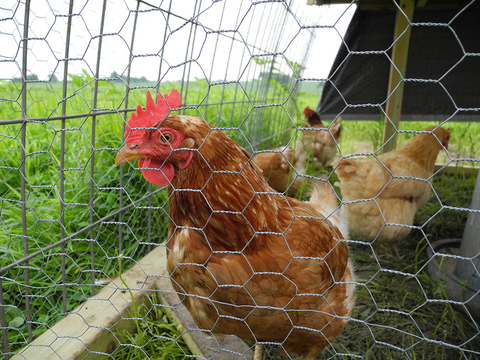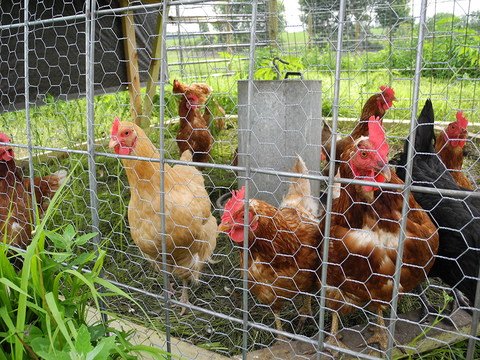Everything You Need to Know About Raising Chickens
Quick facts
- Raising backyard chickens can be a rewarding feel and a great way to teach kids virtually nature, agronomics and responsibility of caring for animals.
- Hens brainstorm laying at around half dozen months of age and tin can continue for 5 to ten years, with peak production occurring in the first two years.
Breeds
At that place are a wide a diversity of chicken breeds, developed for egg product, meat production or good looks. While many breeds are adaptable to a backyard setting, certain breeds are ameliorate than others for backyard weather condition. Medium to large breeds are good for cold winters. A mellow temperament and good egg laying are besides pluses. If you lot run across reference to a bantam bird, that is a small version of whatsoever particular breed. It will await the same only be smaller.
Popular backyard craven breeds
These are a few examples of great, mellow breeds for the backyard.
Rhode Island scarlet
- Hens weigh about 6.5 pounds
- Lay chocolate-brown eggs
- Nighttime ruby-red feathers
- Dual purpose breed, but most often used for laying
- Hardy breed that does well in small flocks
Wyandotte
- Hens weight about 6.5 pounds
- Lay chocolate-brown eggs
- Dual purpose breed
- Slap-up for small flocks and rugged weather
- "Curvy" shape, good disposition
- Many color varieties
Ameraucana
- Many unlike color varieties
- Lay green eggs
- Great long-term egg production
- Dual purpose brood
- Tolerant to all climates
- Piece of cake to handle
Orpington
- Hens weigh about 8 pounds
- A larger dual purpose breed
- Lay chocolate-brown eggs
- Many color varieties
- Heavy size is platonic for cold weather
Diet
Chickens are omnivores. They consume grains, fruits, vegetables and insects. Chickens should typically be fed a prepared feed that is balanced for vitamins, minerals and poly peptide. A salubrious laying hen diet should as well comprise crushed oyster beat for egg production and dust for digestion. A 6-pound hen volition eat roughly 3 pounds of feed each calendar week.
They love fruit and vegetable scraps from the kitchen and garden as well as bread. Scratch-cracked corn and oats are a nice care for for the chickens that does non supply all their nutritional needs but is fine in moderation.
Feed consumption may increment in the winter when they burn more calories, and information technology may decrease in the estrus of the summer. A disquisitional part of a chicken'south diet is continual access to clean, fresh water. This is particularly true in the summer as they cool themselves by panting.
Housing
A quality coop is essential to lawn chicken production. Coops must provide protection from the weather and predators.
Layers need nest boxes — one per 4 to v birds. Chickens are descended from jungle birds, which means they similar to exist upwardly high, so a place for them to roost is important.
At that place should be a well-insulated surface area with a light seedling or oestrus lamp for the wintertime months as well as ventilation for fresh air. Exist sure to have a minimum of 3 to 5 square feet per bird, including outdoor space.
There is an countless diversity of coop designs with merely as much range in toll. Find a design that provides piece of cake access and otherwise suits your state of affairs. At that place are many books and websites with coop designs.
Predators
Their main predators are raccoons, rats, owls, hawks and cats. An enclosed infinite for chickens to stay at night is essential to their protection. Ensure that the coop is free of small holes for predators to sneak in. The space should exist free of unnecessary objects like woodpiles or equipment, as they attract predators.
Daily care
Chickens need to be fed and water inverse daily. They need to be let out of the coop each morning and put into the coop at dusk each nighttime to protect them from predators. Eggs should be picked up twice a day. The coop and pen should be cleaned out weekly to maintain sanitation and scent control.
Bird health
Healthy birds will be active and alert with vivid eyes. They volition be moving around — pecking, scratching and dusting — except on hot days when they will observe shade. Chickens that are salubrious and active will likewise talk and sing quietly throughout the mean solar day.
Every bit far as laying and eating habits, each craven is different, so monitor each chicken to become a feel for her normal production and consumption. Healthy debris will be house and grayish dark-brown, with white urine salts. Roughly every tenth dropping is somewhat foamy, smellier than usual and light brownish.
Chickens raised in lawn settings generally stay healthy and are not easily susceptible to diseases. The easiest fashion to observe disease in chickens is to know what a healthy bird looks like. When a craven isn't interim normal, for instance if she doesn't run to the food as usual or she wheezes or sneezes, start investigating.
Possible causes of illness to chickens
Infectious (invasion by some other organism)
- Bacteria
- Mold and fungi
- Parasites
- Viruses
Noninfectious (nonbiological in origin)
- Chemical poisoning
- Hereditary defects
- Nutritional deficiencies
- Unknown causes
Credit:Storey's Guide to Raising Chickens by Gail Damerow
Sanitation
An important element to bird health is sanitation. In guild to maintain a clean, healthy environment, the coop and outdoor area should be cleaned out weekly or as needed to control manure and odor build up. Feeders and waterers should be regularly cleaned and disinfected. Dust baths should be available, every bit they help control mites. Information technology is of import that at to the lowest degree once a year, usually in the spring, a thorough cleaning is washed on the coop and thousand. Also cleaning before introducing new birds to the area will limit the spread of illness. A fall cleaning is also helpful with mite control over winter.
During this cleaning, safety precautions must exist taken in dealing with dust. Clothing a dust mask and mist the walls surrounding the area to command dust motility. Inhalation of stale chicken manure can be harmful to humans. Rake and clean out the yard. All feeders should be removed and bedding completely cleared out. It is important to remove dust and cobwebs from corners of the coop. The inside of the coop needs to be disinfected — including troughs, perches and nests. To disinfect, use i-tablespoon chlorine bleach to ane gallon boiling water.
Learn how to foreclose disease in your poultry with biosecurity.
Manure management
Craven manure is made up of feed rest, intestinal bacteria, digestive juices, mineral by-products from metabolic processes, and water. In fact, 85 percent of chicken droppings, by weight, is water. This leads to problems with humidity and aroma. And then what are the options for managing manure?
- One selection is to complete thorough cleanings of the coop more than once a year. This will control the olfactory property and fly populations.
- Another choice is to pasture the chickens. Moveable shelters are a valuable tool for pasturing chickens and reducing cleaning fourth dimension. Just move the location of the firm when manure begins to build up. It offers new space for chickens to graze and peck, and information technology provides gratis fertilizer for the lawn!
- A tertiary pick is composting. Composting tin exist done right in the chickens' bedding. To first this process, lay down about four inches of bedding. Regularly stir up the bedding to forestall clumping, and add fresh bedding until information technology is x inches deep by winter. Continue this process until the bedding gets 12 to 15 inches deep. At this depth, composting actively begins and later on 6 months tin kill harmful leaner. This composting releases rut, which keeps chickens warm in cooler months and attracts natural fly predators. To maintain the compost, information technology must be stirred regularly to preclude crusting. The aforementioned process tin can be done outside of the coop in a separate bin.
Egg production
Hens begin laying at around six months of age and can proceed for 5 to 10 years with peak production occurring in the first 2 years. They will lay roughly six eggs each calendar week. Egg production drops each year when the hens molt (supplant their feathers in the early on fall) and every bit daylight hours are lost. Hens demand at least 12 to 14 hours of light each mean solar day to continue laying eggs. A regular light seedling is sufficient to supply this light.
Regulations
There are several regulations that you may encounter with chicken ownership. Raising chickens in the backyard may require a permit from your city, and each has different requirements and restrictions. It is not legal in some cities to keep poultry. Some cities may too limit the number of animals you can keep.
If yous begin selling eggs or meat, y'all will encounter additional regulations. The Minnesota Department of Agriculture Dairy and Food Inspection Partition manages and enforces these.
Purchasing birds
In that location are several places to purchase chickens. You lot can social club from major hatcheries online. In that location are too many individuals breeding and selling poultry. Local farm supply stores may as well order them for you lot.
- Storey's Guide to Raising Chickens past Gail Damerow
- American Standard of Perfection past American Poultry Association
Reviewed in 2018
gaillardwharroposs.blogspot.com
Source: https://extension.umn.edu/small-scale-poultry/raising-chickens-eggs



0 Response to "Everything You Need to Know About Raising Chickens"
Post a Comment